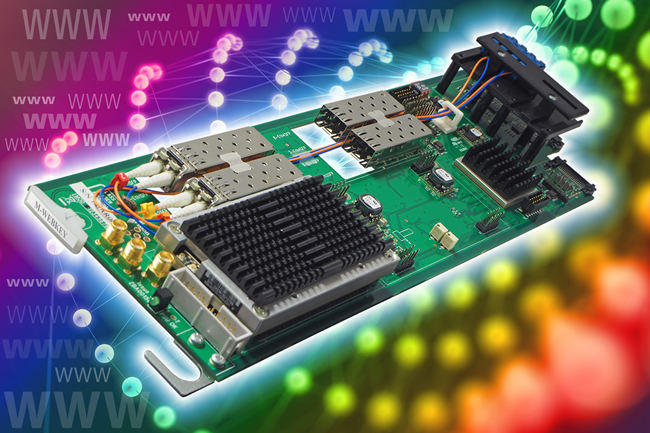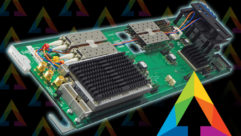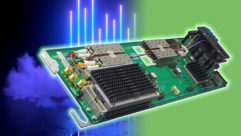
Crystal Vision has introduced a unique new way to do broadcast graphics. Rather than using video sources for the key and fill signals like traditional linear keyers, the M-WEBKEY web page keyer can key a web page on to an IP or SDI video stream – using the power of HTML5, CSS3, JavaScript, AJAX, XML and JSON to add still and animated on-screen text and graphics as well as sophisticated data-driven graphics. The M-WEBKEY is already causing broadcasters to rethink their graphics workflows. Compared to traditional linear keying, this new method of keying is lower cost (no need for an expensive character generator or graphics PC), provides an easier workflow (with less video sources to deal with), simplifies the network (web pages use very little bandwidth compared to uncompressed video), makes efficient use of resources (the broadcaster’s website and programmes can share the same graphics) and makes it easier to find suitable operators (with web page design a common skill). The M-WEBKEY is a software app that runs on the MARBLE-V1 media processor hardware, a card housed in the Vision frame which features a powerful CPU/GPU processor and both SDI and 10GbE IP network interface connections.
The M-WEBKEY allows the video input or a matte color to be set as the background source, with the specified web page providing the overlaid foreground source as well as the key signal which defines the graphic’s location and transparency. The M-WEBKEY will render the web page at the correct resolution and frame rate for the video signal and then key the graphic on to the video. The M-WEBKEY supports all web standards including HTML5, CSS3, JavaScript, AJAX, XML and JSON. Any effect can therefore be easily created, including formatted text, rotating logos, rolling text straps and countdown timers – while dynamic data can be used to update the web page content and produce sophisticated data-driven graphics perfect for sports, financial and shopping channels. Web pages can be accessed remotely – with two DNS servers available via the 10GbE network interface ports – or can be stored internally in the Vision 3 frame, with expandable storage available.
Web page keying has many advantages. Firstly it is lower cost than traditional linear keying. Because the graphic and key signal are from a web page, there is no need for the expensive character generator or graphics PC that would be required if they were video sources. Any number of M-WEBKEY can derive their graphics from the same web server – ideal for multi-channel playout systems. The cost of routing IP is related to the total bandwidth and so web pages save money by using less bandwidth than uncompressed video signals – which has the additional benefit of making the network less complex. Web page keying also makes for a simpler workflow. With the graphic and key signal combined as one source, the broadcast engineer just has one web page to distribute rather than two SDI or IP signals – a benefit which becomes even more advantageous with multi-channel applications. Web page keying also introduces increased efficiency, allowing broadcasters to use the same resources for their broadcast graphics as they do for their website if required. Finally, it is easier to find suitable operators. Web page design is a less specialist skill than operating broadcast graphics, with the easy construction of web pages using free or inexpensive standard web design software.
The M-WEBKEY can be used with IP (SMPTE ST 2022 and ST 2110 video), with SDI or with both IP and SDI at the same time. Its support for multiple signal formats gives the easiest possible SDI to IP upgrade, while also making it perfect for mixed SDI and IP installations as well as fully IP or fully SDI environments. The M-WEBKEY’s gateway functionality can be used to integrate SDI into an IP environment or IP into an SDI environment. Its IP to IP translation functionality can be used for network address translation, protocol conversion (between any of the input formats and any of the output formats), unicast to multicast address conversion and the creation of media firewalls. The IP flows can be separated and protected across up to four bi-directional 10GbE SFP+ network interfaces. It includes output traffic shaping and is tolerant of any input packet distribution.
Explained Crystal Vision’s Managing Director, Philip Scofield: “The M-WEBKEY helps our customers to move more of the production process to general purpose web-based systems and still keep full broadcast quality for both IP and SDI based architecture. It’s ideal for anyone trying to reduce the cost of creating video graphics – from the small broadcaster with one channel to the large broadcaster with lots of specialist channels.”
The M-WEBKEY’s useful features include the ability to fade the key up and down, crops to force areas of background or foreground, a framestore synchronizer, ten frames of video delay and signal status monitoring. There is a flexible choice of software and hardware control options, including the VisionWeb Control web browser software and complimentary SNMP.
The M-WEBKEY software app is available to buy now.
Based at Whittlesford near Cambridge in the UK and with an office in the USA, Crystal Vision provides a full range of interface and keyers and helps people transition through a range of technologies – from SD to HD, from HD to IP and from IP to IP.










